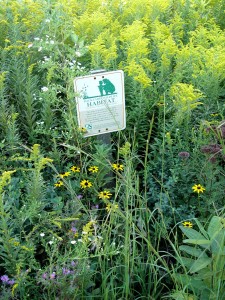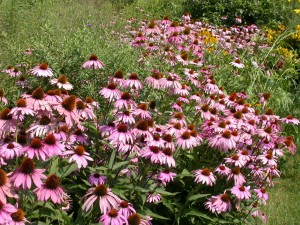Going Native?
February 11th, 2014
One of gardening’s hot buzzes in the last few years has been interest in planting more native plants.
It’s also been one of gardening’s hot buttons, sometimes creating controversy and friction between nature-leaners and those who don’t care where a plant is from so long as it doesn’t die in their yard.
Me? I’m on the garden fence. I appreciate both viewpoints and don’t think the native question has to be an all-or-evil matter.
Yes, it makes sense to plant more native plants. They’re adapted to our soils and climate, they tend to be most attractive to our native wildlife and pollinators, and they help our landscapes look like here, giving us a distinctive regional identity.
One of the biggest arguments is that it avoids the risk of encouraging any more invasive non-natives that have become some of our worst weeds.
On the other hand, just because a plant is native doesn’t mean it’ll never die or require no care. You still have to get the right plant in the right place – native or not.
Also, not everyone likes the looks of many native plants. Some see them as generallly “messy” or “weedy.”
And native plants may attract wildlife you don’t want, such as groundhogs, deer, rabbits, voles, skunks, ticks, mosquitoes, snakes, etc.
Things get even more complicated when you try to define exactly what a native plant is. Not everyone agrees.
Generally, the definition of a native is a plant growing in a particular area at the time European settlers arrived.
That makes the assumption that it was fine for the rest of nature (excluding people) to work out what plants ended up where.
In other words, if wind or water or insects or pre-Europeans moved a plant around, that was OK. But once the Europeans got involved in moving plants, that’s when the trouble started.
Defining how local a plant has to be in order to be considered native is another uncertainty.
Some people are fine with a plant being “native” so long as it was growing somewhere in the United States when the Europeans arrived.
Purple coneflower is an example of a plant that’s native to the Midwest U.S. prairies but not exactly to Harrisburg. Nevertheless, it shows up on most native plant lists.
That raises questions about artificial political boundaries and whether we ought not to consider a plant from Ontario being a better fit in Harrisburg than one from Alaska or Hawaii or Florida.
Some solve that by saying the answer is sticking with plants that are as locally native as possible. That means we should consider a “native” to be only something that’s native to the Northeast United States or to Pennsylvania or even to central Pennsylvania.
If you manage to come to grips with all of that, here’s another curveball that Harvard’s Peter del Tredici has tossed out there… the planting situations we’re dealing with today are nothing like the environment of 300 years ago.
He contends that we’ve bulldozed our urban and suburban soils, drastically altered our air and light situation with cars, buildings and such, and had the climate around us change. The result is that the plants best adapted to the new conditions may very well be ones different from what were best adapted 300 years ago.
He even argues that we might be better off accepting some weeds as the “new winners” because they’ll thrive without spraying, watering and other heroic measures better than some natives that aren’t happy with the new situation.
To me, it all adds up to an issue that’s not as simple as concluding, “Natives are good and non-natives are bad and invasive.”
If you’re intrigued by the topic, I’ll be doing a talk called, “Going Native? Pennsylvania Plants for Pennsylvania Yards” at this year’s Pennsylvania Garden Expo.
It’s scheduled for Sun., Feb. 23, at 2 p.m. on the show’s main stage, inside the Pennsylvania Farm Show Complex along Cameron Street in Harrisburg. The talk (as with all Expo talks) is free with admission to the show.
I’ll try to help you weigh the pros and cons, tell you what I’ve concluded, give you a few resources on how to determine whether a plant is native or not, and show you some of my favorite garden-worthy native plants.
See you there. I’m also doing talks on show Friday and Saturday (Feb. 21 and 22). My other times and topics are listed on George’s Talks and Trips page or you can see the entire Expo seminar lineup on the show’s web site.









